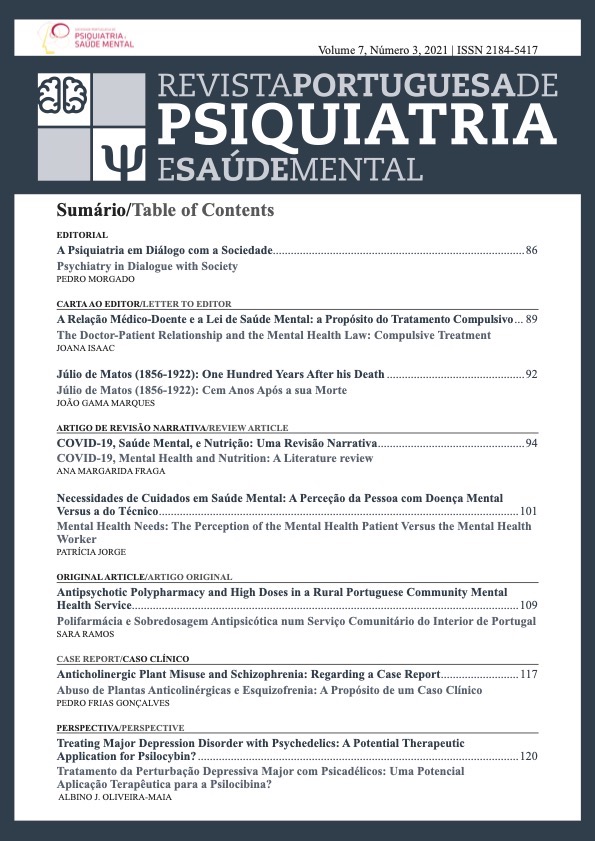Anticholinergic Plant Misuse and Schizophrenia: Regarding a Case Report
DOI:
https://doi.org/10.51338/rppsm.2021.v7.i3.191Keywords:
Antipsychotic Agents, Behavior, Addictive, Cholinergic Antagonists, Schizophrenia, Substance‑Related DisordersAbstract
Anticholinergic medication abuse is common in patients with schizophrenia. The recreational use of anticholinergic plants for their euphoria inducing and hallucinogenic properties is a rising concern in America and Eastern Europe, but rare in Portugal. Anticholinergic misuse poses a challenge to Psychiatrists treating patients with dual pathology, for its addictive potential. In managing antipsychotic medication and its side effects in this population one must have in mind the potential for abuse of anticholinergics. We present a case report of a patient with schizophrenia and abuse of anticholinergic plants, after receiving biperiden to treat extrapyramidal symptoms. Later we discuss anticholinergic effects and potential for addiction and explore ways to prevent and treat drug misuse in this context.
Downloads
References
Naja, W. J., & Halaby, A. (2017). Anticholinergic Use and Misuse in Psychiatry: A Comprehensive and Critical Review. Journal of Alcoholism & Drug Dependence, 5(2). doi:https://doi.org/10.4172/2329-6488.1000263
Ogino, S., Miyamoto, S., Miyake, N., & Yamaguchi, N. (2013). Benefits and limits of anticholinergic use in schizophrenia: Focusing on its effect on cognitive function. Psychiatry and Clinical Neurosciences, 68(1). doi:https://doi.org/10.1111/pcn.12088
Ghossein, N., Kang, M., & Lakhkar, A. D. (2020). Anticholinergic Medications. StatPearls [Internet]. Retrieved from https://www.ncbi.nlm.nih.gov/books/NBK555893/
Brown, D. A. (2019). Acetylcholine and cholinergic receptors. Brain and Neuroscience Advances, 3. doi:https://doi.org/10.1177/2398212818820506
Possible Long-Term Health Effects of Short-Term Exposure to Chemical Agents: Volume 1 Anticholinesterases and Anticholinergics. (1982). National Research Council (US) Panel on Anticholinergic Chemicals., 3.
Marken, P. A., Stoner, S. C., & Bunker, M. T. (1996). Anticholinergic Drug Abuse and Misuse Epidemiology and Therapeutic Implications. CNS Drugs, 5(3), 190-199. doi:https://doi.org/10.2165/00023210-199605030-00005
Buhrich, N., Wellwe, A., & Kevans, P. (2000). Misuse of Anticholinergic Drugs by People With Serious Mental Illness. Psychiatric Services, 51(7), 928-929. doi:https://doi.org/10.1176/appi.ps.51.7.928
Pereira, S. R., & Albert, M. (2017). Anticholinergic discontinuation for antipsychotic‐induced extra‐pyramidal symptoms. Cochrane Database Syst Rev, 3. doi:https://doi.org/10.1002/14651858.CD012525
Feo, V. D. (2004). The Ritual Use of Brugmansia Species in Traditional Andean Medicine in Northern Peru. Economic Botany, 58, 221-229.
Kerchner, A., & Farkas, Á. (2019). Worldwide poisoning potential of Brugmansia and Datura. Forensic Toxicology, 38, 30-41. doi:https://doi.org/10.1007/s11419-019-00500-2
WHO. (2004). ICD-10 : international statistical classification of diseases and related health problems. Geneva: World Health Organization.
Campbell, N., Boustani, M., Limbil, T., Ott, C., Fox, C., Maidment, I., . . . Gulati, R. (2009). The cognitive impact of anticholinergics: A clinical review. Clin Interv Aging, 4, 225-233. doi:https://doi.org/10.2147/cia.s5358
Tandon, R., & Greden, J. F. (1989). Cholinergic Hyperactivity and Negative Schizophrenic Symptoms A Model of Cholinergic/Dopaminergic Interactions in Schizophrenia. Arch Gen Psychiatry, 46, 745-753. doi:https://doi.org/doi:10.1001/archpsyc.1989.01810080075010
Erskine, D., Taylor, J.-P., Bakker, G., Brown, A. J. H., Tasker, T., & Nathan, P. J. (2019). Cholinergic muscarinic M1 and M4 receptors as therapeutic targets for cognitive, behavioural, and psychological symptoms in psychiatric and neurological disorders,. Drug Discovery Today, 24(12), 2307-2314. doi:https://doi.org/10.1016/j.drudis.2019.08.009.
Tandon, R., Keshavan, M., & Nasrallah, H. (2008). Schizophrenia, ‘just the facts': what we know in 2008: Part 1: Overview. Schizophrenia Res, 100, 4-19. doi:https://doi.org/10.1016/j.schres.2008.01.022
Lester, D. B., Rogers, T. D., & Blaha, C. D. (2010). Acetylcholine-dopamine interactions in the pathophysiology and treatment of CNS disorders. CNS Neuroscience and Therapeutics, 16(3), 137-162. doi:https://doi.org/10.1111/j.1755-5949.2010.00142.x
Ray, L. A., Meredith, L. R., Kiluk, B. D., Walthers, J., Carroll, K. M., & Magill, M. (2020). Combined Pharmacotherapy and Cognitive Behavioral Therapy for Adults With Alcohol or Substance Use Disorders: A Systematic Review and Meta-analysis. Jama Netw Open, 3(6). doi:https://doi.org/10.1001/jamanetworkopen.2020.8279








